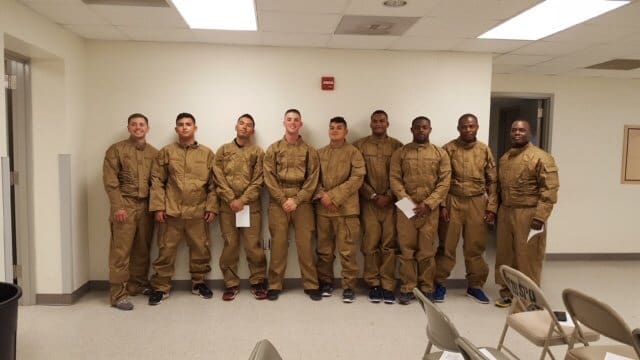FORT BELVOIR, Va. — Fuel handler coveralls are worn by some 17,000 petroleum supply specialists in the Army who fuel trucks, aircraft and boats, and who operate pipelines and storage tanks around the globe.

Soldiers from the 92F petroleum supply specialist military occupational specialty at Fort Hood, Texas, are test wearing four variants of new coveralls during limited user evaluation. (Photo Credit: U.S. Army)
It’s a dirty and often thankless job, but without them, nothing would move, said Captain WaiWah Ellison, assistant product manager with Product Manager Soldier Clothing and Individual Equipment, or PM SCIE, part of Program Executive Office Soldier, known as PEO Soldier. The coveralls are primarily designed to protect Soldiers from spills, which can be hazardous when they make contact with skin.
Last year, the Army was presented with a problem and an opportunity, according to Debbie Williams, a systems acquisition expert with SCIE. The manufacturer of fabric that previously made their coveralls discontinued production, so the Army needed to find a new supplier.
Williams explained that while searching for a new vendor, the Combined Arms Support Command decided to consult with Soldiers to see how they liked the current coveralls and mine their ideas on ways to improve them, noting that CASCOM provides fire support and operational assistance to combat elements.
It was apparent from previous Soldier feedback that an update to the design could assist with making the garment a better fit. And for a long time, this material was the only one known to meet the stringent requirement of being able to resist fuel penetration for at least 12 hours. This was an opportunity to solicit industry and understand what new technologies exist in the fabric industry as well as updates in design.
Soldiers overwhelmingly said fit and comfort would be paramount in the requirements for selection of a new fabric and design.
Williams said that the Soldiers who provided their opinions of the current design were instructors at Fort Lee, Virginia, who teach the 92F petroleum supply specialist military occupational specialty. In an effort to possibly make this a joint service uniform, they also conducted a limited user evaluation of the current design with the Marine Corps fuelers at Camp Lejeune, North Carolina, and received feedback on improvements on the comfort and style.
Multiple companies answered the request for proposals, she said, noting that it takes two vendors to produce the coveralls: a manufacturer who produces the fabric, and another who cuts and sews them.
Two of the designs being evaluated are two-piece and the other two are single-piece coveralls.
Laboratory testing of the four designs took place over the spring and summer at the U.S. Army Natick Soldier Research, Development and Engineering Center in Massachusetts, Williams said. Those tests included flame resistance and tear evaluation.
A four-week, limited user evaluation of the materials and design began on Sept. 17, 2018. Fort Carson, Colorado, was selected for the fabric testing while design tests are located at Fort Wainwright, Alaska, Fort Bliss, Texas and Fort Hood, Texas.
A selection will be made following user testing and Army Test and Evaluation Command certification. A supply request package will then be turned in to Defense Logistics Agency’s Troop Support Office, and once that is completed, production for long-term sustainment can start. Williams said it’s too early to give a production start date.
By David Vergun, Army News Service


Cool I can stop giving them my A2CUs. Bad enough there isn’t enough for flight crew. I always say give them FRACUs. Although nothing funnier then when our replacements arrived and we asked two dudes if they were assault or medevac. They said neither we are refuelers, was just like welp never mind.
That sounds like a AV branch issue. Perhaps you should discuss it with your chain.
I wonder why the army needs a special uniform for fuel handlers….The Air Force gets by with the utility uniform….
Do you wear scrubs? PPE is not limited to body armor and just as an army marches on it’s stomach, it rolls on it’s fuel tanks.
I too wondered this. LOX is the only thing the AF needs coveralls for; must be an Army thing.
Probably because the Army fuels vehicles in all environments, not just on a nice clean concrete pad. On top of that, those fuel trucks make great targets.
These are Gore Pyrad, flame resistant, fuel/oil resistant suits. The fabric is much lighter weight than the older Nomex Gore coveralls.
Make the onesie great again!